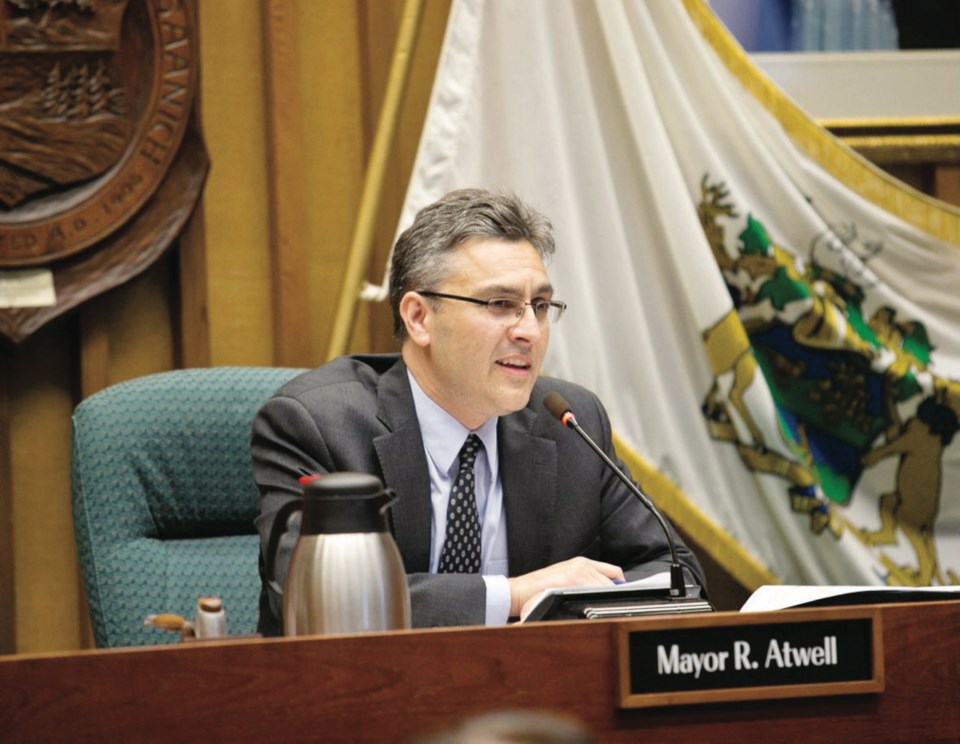If the Capital Regional District can’t get its act together on sewage treatment this year, Mayor Richard Atwell will recommend a made-in-Saanich solution.
Good news on the sewage-treatment project continues to be elusive, Atwell said Monday in his annual address at Saanich council. A number of conceptual designs based on a centralized plant at Rock Bay come with a cost starting at just shy of $1 billion, almost double the cost of a rejected project at McLoughlin Point in Esquimalt.
“At the CRD, we continue to struggle with imposed deadlines around funding, difficulties with siting and conceptual designs that are lacking not only in innovation, but now come with a price tag that our residents simply cannot afford,” said Atwell, who became a director with the Sewage Treatment Action Group in 2013 before he was elected mayor and is currently vice-chairman of the CRD’s Core Area Liquid Waste Management Committee.
“I will recommend to council that we evaluate a made-in-Saanich solution for treating either liquid waste or solid waste that is the byproduct from wastewater treatment plants or both, because the technology has advanced to the point where an affordable community-based solution is now in reach.”
Victoria Mayor Lisa Helps, chairwoman of the committee, said she was disappointed to hear Atwell musing out loud about potentially pulling out, given that he is the vice-chairman of the committee.
“It’s concerning to hear another municipality talking about pulling out, just as we’re all talking about pulling ahead,” said Helps. “It takes all of us to get our act together. As vice-chair of the committee, he’s got a leadership role to help make the CRD project move ahead.”
Helps said she didn’t know how it would be more affordable for Saanich to treat its own sewage without any government grants.
“Maybe Richard has an idea that we’re not aware of.”
In his address, Atwell stressed the importance of transparency and public accountability in government. In April, council adopted a more citizen-friendly approach, inviting members of the public to speak on a greater number of council agenda items. Atwell said he also made good on his promise of an open-door policy for residents.
“It has been enlightening for me and it has fostered in me a greater appreciation for the diversity, dedication and devotion that exists within our community.”
> See MAYOR’S, page A2
Saanich will move forward this year with a long-awaited update to its website, said Atwell. “Citizens must be able to easily access material well in advance of council meetings and be able through efficient recall to locate the reasoning behind the decisions that we as elected officials have made using their tax dollars.”
The municipality will fulfill that mandate by delivering a webcasting system for council meetings, something that “must be accomplished by the middle of 2016,” he said. “Webcasting has become a prevalent online service of local government within this region for working families and others who cannot attend meetings.”
Atwell also promised to improve the Environmental Development Permit Area bylaw, which was adopted in March 2012. The bylaw, which affects about 2,000 private properties in Saanich, requires homeowners to obtain permits for everything from paving to planting new gardens if the municipality believes a sensitive ecosystem will be affected.
“Who could have predicted that four years later, this bylaw would be causing so much discontent within our community. It is now unfortunately pitting residents against each other in an almost hegemonic battle over stewardship of the environment, straddling park land and private land and to the waterfront and elsewhere,” said Atwell.
The district held two open houses on the bylaw, which led to a town hall meeting in November. Because of overwhelming demand, a second town hall meeting will be held soon, said Atwell.
“After listening to the public, we must at that time follow through on the best advice and act accordingly to improve the bylaw and reinstill public confidence,” he said.
While she’s grateful to Atwell for recognizing that the bylaw is a major issue for many residents, Anita Bull, head of the lobby group pushing to have the bylaw recrafted, said the municipality needs to get on with its second town hall.
“The residents were told a second town hall would take place by the end of January and that is not happening. The residents have been getting upset because they’re not seeing any move from Saanich council,” said Bull, president of Saanich Citizens for Responsible EDPA Society.
“They need to book the town hall as soon as possible and at that meeting we’d like to hear what the plan is for going forward. We need to know what’s next.”
And although many residents cheered the announcement that the federal and provincial governments had committed $85 million toward an interchange at McKenzie, Admirals and Highway 1, Saanich’s traffic problems do not begin and end at the highway, the mayor said. Traffic congestion comes from the highway accesses into many areas of Saanich, he said.
“There is a great need to accelerate our plans to deal with the congestion at the Wilkinson/Interurban intersection and other problematic intersections,” said Atwell, who wants council to focus on these areas in an upcoming strategic-planning process.



